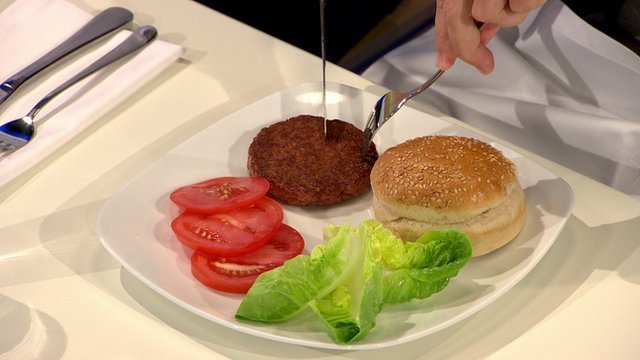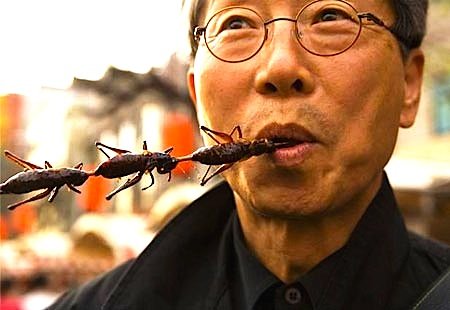Frankenburger, the world’s first lab-grown burger, was cooked and eaten at a news conference in London today.
Dutch scientists took cells from a cow and turned them into strips of muscle that they combined to make a patty.
Researchers say the technology could be a sustainable way of meeting what they say is a growing demand for meat.
Critics say that eating less meat would be an easier way to tackle predicted food shortages.
The burger was cooked by chef Richard McGowan, from Cornwall, and tasted by food critics Hanni Ruetzler and Josh Schonwald.
Upon tasting the burger, Austrian food researcher Hanni Ruetzler said: “I was expecting the texture to be more soft… there is quite some intense taste; it’s close to meat, but it’s not that juicy. The consistency is perfect, but I miss salt and pepper.”
She added: “This is meat to me. It’s not falling apart.”
Food writer Josh Schonwald said: “The mouthfeel is like meat. I miss the fat, there’s a leanness to it, but the general bite feels like a hamburger.
“What was consistently different was flavor.”
Prof Mark Post, of Maastricht University, the scientist behind the burger, remarked: “It’s a very good start.”
He said the meat was made up of tens of billions of lab-grown cells. Asked when lab-grown burgers would reach the market, he said: “I think it will take a while. This is just to show we can do it.”
Sergey Brin, co-founder of Google, has been revealed as the project’s mystery backer.

The world’s first lab-grown burger was cooked and eaten at a news conference in London
Prof. Tara Garnett, head of the Food Policy Research Network at Oxford University, said decision-makers needed to look beyond technological solutions.
“We have a situation where 1.4 billion people in the world are overweight and obese, and at the same time one billion people worldwide go to bed hungry,” she said.
“That’s just weird and unacceptable. The solutions don’t just lie with producing more food but changing the systems of supply and access and affordability, so not just more food but better food gets to the people who need it.”
Stem cells are the body’s “master cells”, the templates from which specialized tissue such as nerve or skin cells develop.
Most institutes working in this area are trying to grow human tissue for transplantation to replace worn-out or diseased muscle, nerve cells or cartilage.
Prof. Mark Post is using similar techniques to grow muscle and fat for food.
He starts with stem cells extracted from cow muscle tissue. In the laboratory, these are cultured with nutrients and growth-promoting chemicals to help them develop and multiply. Three weeks later, there are more than a million stem cells, which are put into smaller dishes where they coalesce into small strips of muscle about a centimetre long and a few millimetres thick.
These strips are collected into small pellets, which are frozen. When there are enough, they are defrosted and compacted into a patty just before being cooked.
Because the meat is initially white in color, Helen Breewood – who works with Prof. Mark Post – is trying to make the lab-grown muscle look red by adding the naturally-occurring compound myoglobin.
“If it doesn’t look like normal meat, if it doesn’t taste like normal meat, it’s not… going to be a viable replacement,” she said.
She added: “A lot of people consider lab-grown meat repulsive at first. But if they consider what goes into producing normal meat in a slaughterhouse, I think they would also find that repulsive.”
Currently, this is a work in progress. The burger revealed today was colored red with beetroot juice. The researchers have also added breadcrumbs, caramel and saffron, which were intended to add to the taste, although Hanni Ruetzler said she could not taste these.
At the moment, scientists can only make small pieces of meat; larger ones would require artificial circulatory systems to distribute nutrients and oxygen.
[youtube 1HgstR1K5OQ]
The United States has confirmed the decision to put on hold planned food aid to North Korea.
The decision comes after Pyongyang announced a new rocket launch, which the US says breaks the terms of a deal agreed last month.
Earlier reports that the food aid plans had been suspended were confirmed by a Pentagon official on Wednesday.
Peter Lavoy told lawmakers North Korea had violated a missile test moratorium agreement and could not be trusted to deliver the aid properly.
Under the deal signed in February, North Korea agreed to a partial freeze in nuclear activities and a missile test moratorium in return for US food aid.
Peter Lavoy, acting assistant secretary of defense for Asian and Pacific affairs, told a government committee that next month’s planned rocket launch “reflects [North Korea’s] lack of desire to follow through on their international commitments and so we’ve been forced to suspend our activities to provide nutritional assistance”.

The United States has confirmed the decision to put on hold planned food aid to North Korea
North Korea claims the launch – which is scheduled for between April 12-16 – is only a satellite and is for scientific purposes.
But the US and North Korea’s neighbors insist it will be a long-range missile test, breaking the terms of last month’s agreement.
The US has not delivered food aid to North Korea since 2009, but sent officials to Pyongyang’s ally China earlier this month to finalize plans to re-start food deliveries.
North Korea has suffered persistent food shortages since a famine in the 1990s, and relies on foreign aid to feed its people.
The planned 240,000 tons of food aid from the US was to go to children and pregnant women.
European Union has decided to spend 3 million Euros to research “the potential of insects as an alternative source of protein”.
EU says that research projects will be selected during this year.
Food experts agree that insects would probably have to be disguised for European audiences, so the insect “food” could be used as an additive in burgers and other fast food.
The UN’s Food Standards Authority says of the research: “While insects have not traditionally been used for food in the UK or elsewhere in the European Union, it is estimated that about 2.5 billion people across the world have diets that routinely include insects.
“While many insects are regarded as pests, the UN’s Food and Agriculture authority is interested in promoting edible insects as a highly sustainable source of nutrition.”
Some worms contain three times as much protein as beef per ounce, while four crickets have as much calcium as a glass of milk.
Daniel Creedon, a chef who serves ants, locusts and bees in honey at the London Archipelago restaurant, said: “If insects start coming into the food chain they are probably going to have to be disguised.
“Food producers will probably get away with describing it as animal based proteins. Not many people will buy a locust burger.”
Website Treehugger said: “It is not hard to imagine the development of an insect-based food additive that enriches burger and nugget protein levels.
“Burgers with processed insect meal could be sold by chains under claims such as <<higher in protein>>, <<healthier fats>> and <<eco-burger>>.”

European Union has decided to spend 3 million Euros to research “the potential of insects as an alternative source of protein”
80% of countries on Earth already eat insects, and more than 2,000 insect species are often eaten by human beings.
Unlike conventional livestock, insects and bugs need little space and can be bred in sealed buildings under natural light where they live off waste, paper and algae.
The idea has previously been backed by the UN and EU as a way to tackle food shortages.
Some academics believe that the expense and environmental cost of raising livestock means that insect-eating will be inevitable – and it has been claimed that by the end of this decade, insect-eating will be widespread.
Prof. Marcel Dicke from Wageningen University in the Netherlands said: “The most important thing is getting people prepared, getting used to the idea. Because from 2020 onwards, there won’t be much of a choice for us.”
An estimated 2,000 insect species are consumed around the world, and people do not just eat insects, they relish them as delicacies. In Africa, caterpillars and winged termites are fried and eaten as roadside snacks (after wings, legs, and bristles are removed, of course), and often considered tastier than meat. Grasshoppers and bee larvae seasoned with soy sauce are favorites in Japan, where pricey canned insects are also available. Papua New Guinea is known for its nutty-flavored sago grubs (Rhynchophorus ferrugineus papuanus or R. bilineatus), beetle larvae that inhabit dead sago palm trees and are honored at annual festivals.
Insects often contain more protein, fat, and carbohydrates than equal amounts of beef or fish, and a higher energy value than soybeans, maize, beef, fish, lentils, or other beans. According to a 2004 United Nations Food and Agriculture Organization (FAO) report, caterpillars of many species are rich in potassium, calcium, magnesium, zinc, and iron, as well as B-vitamins. In some African regions, children fight malnutrition by eating flour made out of dried caterpillars. Pregnant and nursing women as well as anemic people also eat caterpillar species high in protein, calcium, and iron.



